2025:
Pope, N. H. and A. L. Igel: Counteracting Influences of Gravitational Settling Modulate Aerosol Impacts on Cloud Base Lowering Fog Characteristics, Atmos. Chem. Phys, 25, 5433–5444. [Link]
2024:
Dye, A., S. Rauschenbach, S. De Szoeke, A. L. Igel, Y. Jin, J. Kim, M. A. Krawchuk, K. Maes, L. O’Neill, K. T. Paw U, R. Samelson, D. Shaw, C. Still, 2024: Fog in western coastal ecosystems: inter-disciplinary challenges and opportunities with example concepts from the Pacific Northwest, USA, Front. Env. Sci., in press.
Igel, A. L., 2024: Processes Controlling the Entrainment and Liquid Water Response to Aerosol Perturbations in Non-Precipitating Stratocumulus Clouds, J. Atmos. Sci., 81, 1605-1616, [Link]
Hu, A. Z. and Igel, A. L., 2024: Bulk Microphysics Schemes May Perform Better With a Unified Cloud-Rain Category, J. Adv. Model. Earth Sys., e2023MS004068. [Link]
Sterzinger, L. J. and Igel, A. L., 2024: Above-cloud concentrations of cloud condensation nuclei help to sustain some Arctic low-level clouds, Atmos. Chem. Phys., 24, 3529–3540. [Link]
2023:
Varble, A. C., Igel, A. L., Morrison, H., Grabowski, W. W., and Lebo, Z. J., 2023: Opinion: A critical evaluation of the evidence for aerosol invigoration of deep convection. Atmos. Chem. Phys., 23, 13791-13808. [Link]
Pope, N. H. and A. L. Igel, 2023: Identifying Important Microphysical Properties and Processes for Marine Fog Forecasts. Mon. Wea. Rev., 151, 2427–2441. [Link]
Hu, A. Z. and A. L. Igel, 2023: A Bin and a Bulk Microphysics Scheme Can Be More Alike Than Two Bin Schemes. J. Adv. Model. Earth Sys., 15, e2022MS003303. [Link]
2022:
Sterzinger, L. J., Sedlar, J., Guy, H., Neely III, R. R., and Igel, A. L., 2022: Do arctic mixed-phase clouds sometimes dissipate due to insufficient aerosol? Evidence from comparisons between observations and idealized simulations. Atmos. Chem. Phys. [Link]
Igel, A. L., H. Morrison, S. P. Santos, M. van Lier-Walqui, 2022: Limitations of Separate Cloud and Rain Categories in Parameterizing Collision-Coalescence for Bulk Microphysics Schemes. J. Adv. Model. Earth Sys., 14, e2022MS003039. [Link]
Boutle, I., Angevine, W., Bao, J.-W., Bergot, T., Bhattacharya, R., Bott, A., Ducongé, L., Forbes, R., Goecke, T., Grell, E., Hill, A., Igel, A. L., Kudzotsa, I., Lac, C., Maronga, B., Romakkaniemi, S., Schmidli, J., Schwenkel, J., Steeneveld, G.-J., and Vié, B.: Demistify, 2022: An LES and SCM intercomparison of radiation fog. Atmos. Chem. Phys., 22, 319-333. [Link]
2021:
Williams, A. S. and A. L. Igel, 2021: Cloud top radiative cooling rate drives non-precipitating stratiform cloud responses to aerosol concentration. Geophys. Res. Lett. e2021GL094740. [Link]
Paper Highlight
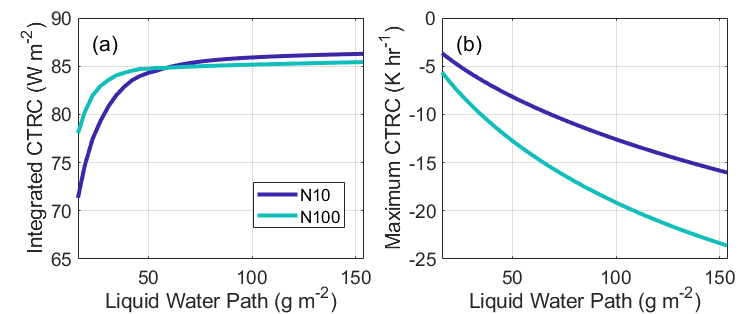
Total cloud top radiative cooling (left) saturates with liquid water path whereas the maximum cloud top radiative cooling (right) does not.
We argue that the maximum cloud top radiative cooling remains sensitive to drop size even if the cloud is otherwise optically thick and that this sensitivity drives non-precipitating stratocumulus cloud responses to increasing aerosol concentration.
Hu, A. Z., A. L. Igel, P. Y. Chuang, and M. K. Witte, 2021: Recognition of Inter‐ vs. Intra‐cloud controls on Droplet Dispersion with Applications to Microphysics Parameterization. J. Geophys. Res. Atmos.. [Link]
Paper Highlight

Left: Cloud-mean correlation is not evident. Right: Local correlation with activation fraction is strong.
We attempt to reconcile the inconsistent sign of the correlation between relative dispersion and droplet concentration by pointing out the distinction between cloud-mean correlation and local correlation within a cloud. Different from past studies, we find that aerosol concentration does not correlate with relative dispersion in terms of cloud-means. For stratocumulus clouds, a new relative dispersion diagnostic equation based on local correlation is proposed for bulk schemes, which replaces the existing one that uses the aerosol-dispersion correlation. We find this equation to be reliable for length scales from 50 m up to 10 km.
Igel, A. L. and S. C. van den Heever, 2021: Invigoration or enervation of convective clouds by aerosols?. Geophys. Res. Lett. 48, e2021GL093804. [Link]
Paper Highlight
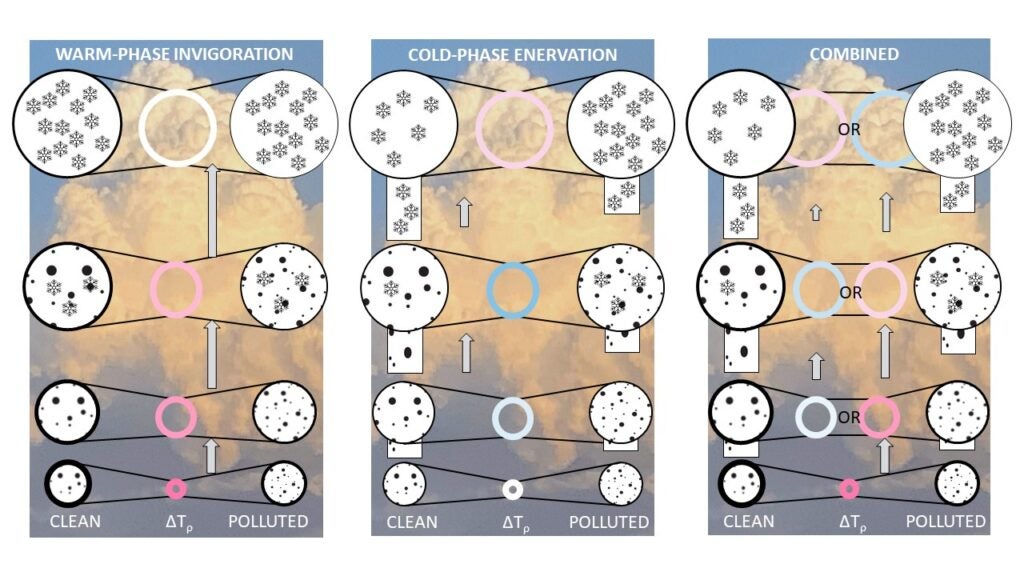
We show that aerosol-induced invigoration cannot occur by additional freezing of condensate alone. Substantial and near-immediate unloading of condensate must occur simultaneously which is unrealistic. Our more realistic assumptions suggest that lofting of additional condensate in polluted storms will usually weaken, not strengthen, invigoration, despite additional freezing. If invigoration occurs, it will likely be through additional low-level condensation and a reduction in supersaturation.
Sterzinger, L. J. and A. L. Igel, 2021: The Effects of Ice Habit on Simulated Orographic Snowfall. J. Hydromet. 22, 1649-1661. [Link]
Paper Highlight
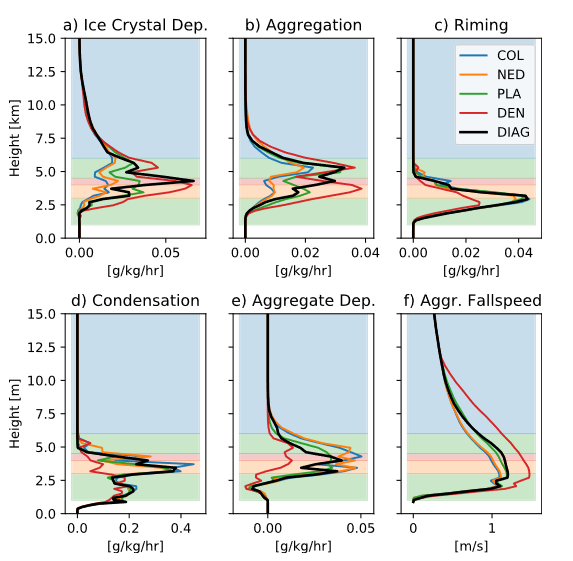
We simulated a wintertime orographic storm over the Sierra Nevada Mountains with RAMS and found that allowing the model to vary ice habit in time and space resulted in 37% more accumulated ice precipitation than simulating the storm with a fixed ice habit. We found that the variability of various ice processes with different habits effectively maximized ice growth in the variable habit simulation when compared to any single-habit simulation, highlighting the importance of accounting for time and space variation of ice properties in these types of storms.”
Sedlar, J., A. L. Igel, and H. Telg, 2021: Processes contributing to cloud dissipation and formation events on the North Slope of Alaska. Atmos. Chem. Phys., 21, 4149–4167. [Link]
Paper Highlight
Coming soon.
Bulatovic, I., A. L. Igel, C. Leck, J. Heintzenberg, I. Riipenen, A. M. L. Ekman, 2021: The importance of Aitken mode aerosol particles for cloud sustenance in the summertime high Arctic — a simulation study supported by observational data. Atmos. Chem. Phys., 21, 3871-3897. [Link]
Paper Highlight

We show that the concentration of Aitken mode particles can have a significant control on the Arctic mixed-phase cloud properties when the accumulation mode concentration is low. Low accumulation mode concentration is common in the remote Arctic.
2020:
Park, J. M., S. C. van den Heever, A. L. Igel, L. D. Grant, J. S. Johnson, S. M Saleeby, S. D. Miller, J. S. Reid, 2020: Environmental Controls on Tropical Sea Breeze Convection and Resulting Aerosol Redistribution. J. Geophys. Res., 125, e2019JD031699. [Link]
Paper Highlight
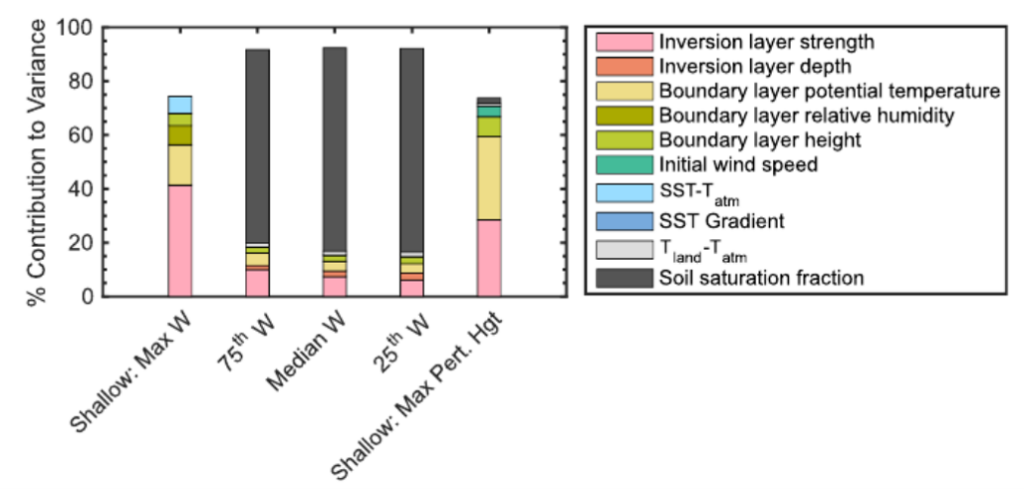
Following on from the Igel et al. (2018) paper, we examined the sensitivity of sea breeze properties to environmental factors with a focus this time on sea breezes associated with cloud development. Many similar results were found but one notable contribution of this paper is the analysis of updraft speeds. Different controls are found for deep and shallow convective regimes as shown by the figure where the maximum updraft speed (w) is a proxy for the deep convective updrafts and other quantiles characterize the shallow convective updrafts.
2019:
Igel, A. L., 2019: Using an Arbitrary Moment Predictor to Investigate the Optimal Choice of Prognostic Moments in Bulk Cloud Microphysics Schemes. J. Adv. Model. Earth Sys., 11, 4559-4575. [Link]
Paper Highlight

I developed a bulk microphysics scheme from a bin microphysics scheme called the Arbitrary Moment Predictor (AMP). AMP is unique in that it can predict any set of two or three distribution moments. It is also unique in that simulations with AMP can be directly compared to simulations with the bin scheme upon which it is built for a truly apples-to-apples comparison of the two scheme types. In this study I find that AMP compares most favorably to a bin scheme for a different set of predicted moments for cloud droplet condensation, evaporation, and collision-coalescence. On average, predicting the 3rd and 4th moments minimizes the error for a double-moment AMP configuration. This is in contrast to a typical bulk scheme configuration that predicts the 0th and 3rd moments.
Falk, N. M., A. L. Igel, and M. R. Igel, 2019: The Relative Impact of Ice Fall Speeds and Microphysics Parameterization Complexity on Supercell Evolution. Monthly Weather Review, 147, 2403-2415. [Link]
Paper Highlight
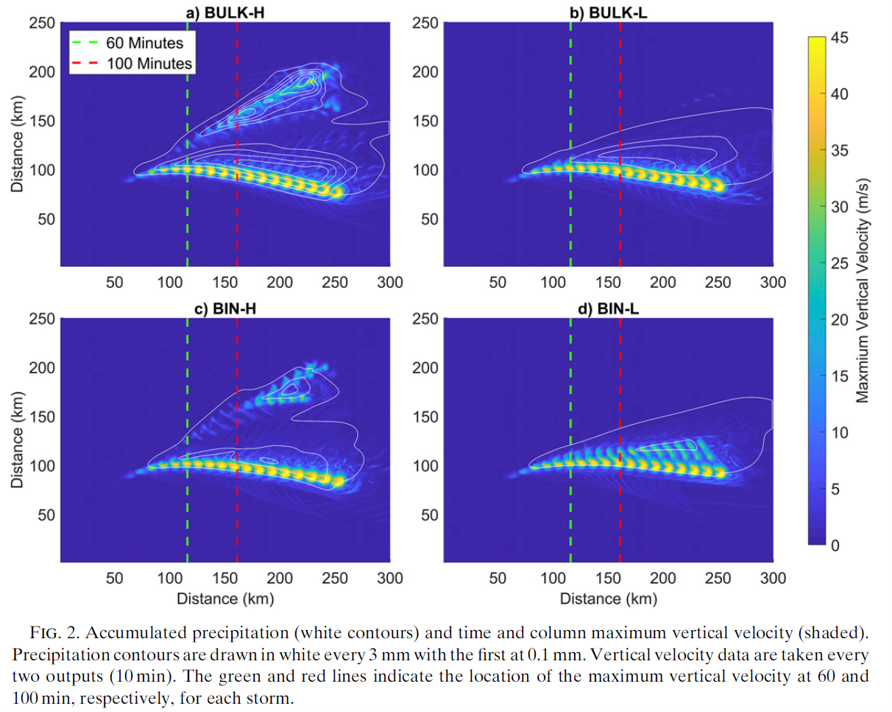
Bin and bulk microphysics schemes often result in starkly different simulations, but the difference aren’t necessarily tied to the fundamental structural nature of each scheme. Here we found that a bulk scheme produced a strongly splitting supercell whereas a bin scheme produced a weakly splitting storm. The degree of splitting could be flipped simply by modifying the large ice fall speeds. The study highlights the difficulties in comparing bulk and bin schemes.
Freeman, S. W., A. L. Igel, and S. C. van den Heever, 2019: Relative Sensitivities of Simulated Rainfall to Fixed Shape Parameters and Collection Efficiencies. Q. J. R. M. S., 145, 2181-2201. [Link]
Paper Highlight
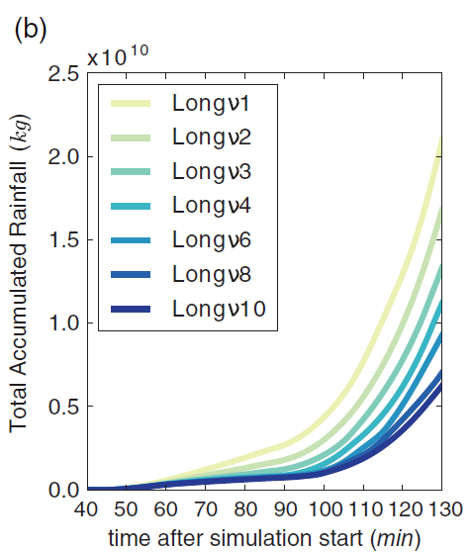
In double-moment bulk schemes, an assumption must be made regarding the shape parameter in the gamma PDFs used to approximate all hydrometeor size distributions. Here we show that the choice of the rain shape parameter can have a large influence on the total accumulated precipitation. The results call for better treatment of size distibution shapes.
Nelson, E. N., T. S. L’Ecuyer, A. L. Igel, and S. C. van den Heever, 2019: An Interactive Online Educational Applet for Multiple Frequencies of Radar Observations. BAMS., 101, 747-751. [Link]
Applet Information
This paper describes an online applet for understanding radar observations. The applet itself can be found here.
2018:
Igel, M. R. and A. L. Igel, 2018: The Energetics and Magnitude of Hydrometeor Friction in Clouds. J. Atmos. Sci., 74, 1343-1350. [Link]
Paper Highlight
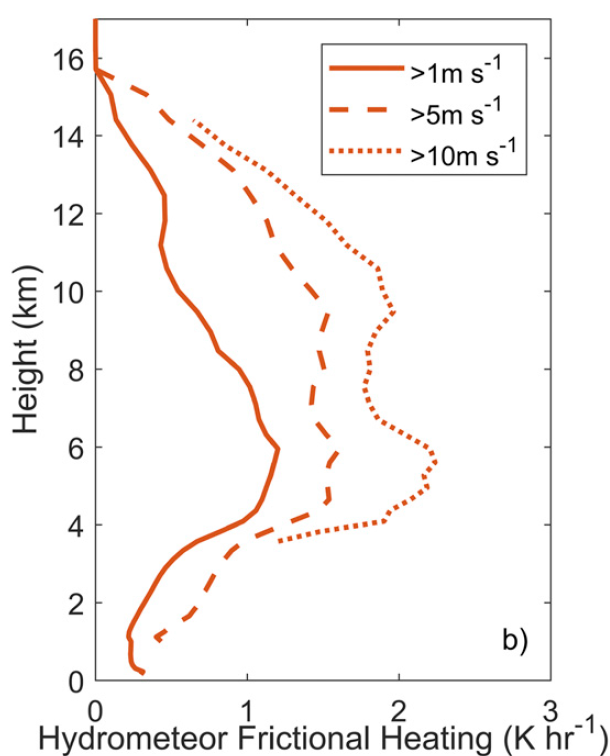
As raindrops and other hydrometeors fall, they produce a small amount of friction with the air. That friction is dissipated to heat. In this paper, we describe how much heat is produced by falling raindrops in clouds and how that heat affects the properties of rain-producing clouds. Maximum heating occurs in the cores of deep convective clouds at about ~10K/hr. We also show that the atmosphere recovers nearly 100% of the energy it expends to loft hydrometeors and water vapor through this frictional heating.
Igel, A. L., S. C. van den Heever, and J. S. Johnson, 2018: Meteorological and Land Surface Properties Impacting Sea Breeze Extent and Aerosol Distribution in a Dry Environment. J. Geophys. Res. 123, 22-37. [Link]
Paper Highlight
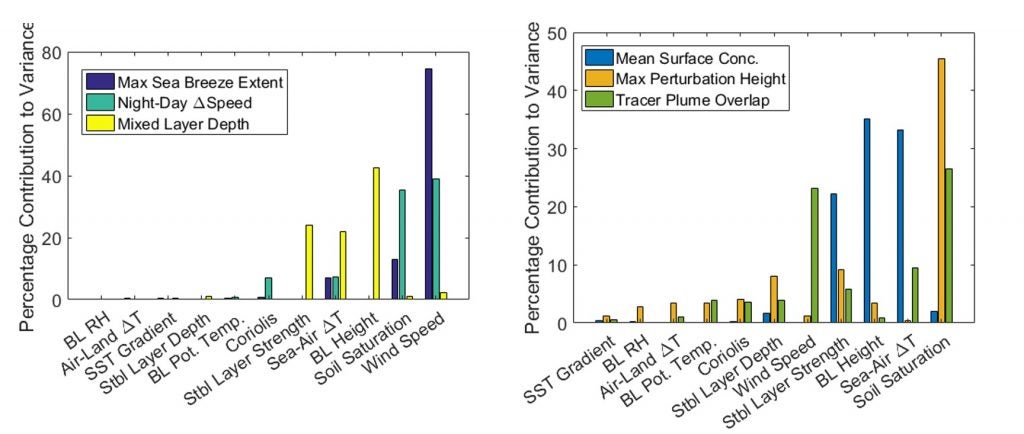
Sea breeze properties are known to be sensitive to many different meteorological and land surface properties, but previous studies have only been able to assess the importance of one to three of these factors at a time. In this study, we assess simultaneously the relative importance of eleven environmental properties for sea breeze properties and aerosol redistribution using a combination of models simulations and statistical emulation of the model output. The figures (Figs. 5 and 9 in the paper) show that wind speed and the sea-air temperature difference, perhaps unsurprisingly, are important for controlling these properties. Other important factors, such as the soil moisture content, are more unexpected. The results of the study highlight future avenues of research and identify ways in which models could be improved for better forecasts of sea breezes and air quality.
2017:
Igel, A. L., A. M. L. Ekman, C. Leck, M. Tjernström, J. Savre, and J. Sedlar, 2017: The Free Troposphere as a Potential Source of Arctic Boundary Layer Aerosol Particles. Geophys. Res. Lett., 44, 7053-7060. [Link]
Paper Highlight

Sources of aerosol particles are scarce in the Arctic. Here we show that the free troposphere may be an underappreciated source of particles. Observations from the ASCOS campaign show that high concentrations of particles may often be in contact with the boundary layer top (left). Model simulations show that when present, these particles can easily be entrained into the Arctic boundary layer. This transport is aided by clouds that may be present. A unique aspect of Arctic stratocumulus clouds is that they often extend above the boundary layer top. Aerosol particles then may be activated to cloud droplets above the boundary layer top, transported by cloud motions to cloud base, sediment out of the cloud and be regenerated when the drops evaporate below cloud base. The simulations systematically varied the boundary layer aerosol concentration (AER) and above boundary layer aerosol concentration gradient (GR).
Igel, A. L. and S. C. van den Heever, 2017: The Role of the Gamma Function Shape Parameter in Determining Differences between Condensation Rates in Bin and Bulk Microphysics Schemes. Atmos. Chem. Phys. 17, 4599-4609. [Link]
Paper Highlight

A portion of Fig. 5. A comparison of condensation (left column) and evaporation (right column) rates from bin and bulk schemes. Each colored line represents a distribution of the log(rate ratios) for a different pair of simulations. Raw comparisons are shown in the top row. It can be seen that the two schemes often do not agree. When differences in rates due to distribution shape are accounted for, the agreement becomes markedly better (bottom row). This result points to a need for better assumptions regarding the assumed PDF shape in bulk microphysics schemes.
Igel, A. L. and S. C. van den Heever, 2017: The Importance of the Shape of Cloud Droplet Size Distributions in Shallow Cumulus Clouds. Part I: Bin Microphysics Simulations. J. Atmos. Sci. 74, 249-258. [Link]
Paper Highlight

Some bulk microphysics schemes use the cloud droplet number concentration to diagnose the shape parameter of the gamma PDF (dashed lines). The relationship between these two quantities is not unique, and more research needs to be done in order to better diagnose the shape parameter. This paper suggests that diagnosing this parameter based on both the droplet concentration and the aerosol concentration would lead to improvements. Figure 7a from the paper is shown above. Different colors show results from simulations with different aerosol concentration.
Igel, A. L. and S. C. van den Heever, 2017: The Importance of the Shape of Cloud Droplet Size Distributions in Shallow Cumulus Clouds. Part II: Bulk Microphysics Simulations. J. Atmos. Sci. 74, 259-273. [Link]
Paper Highlight
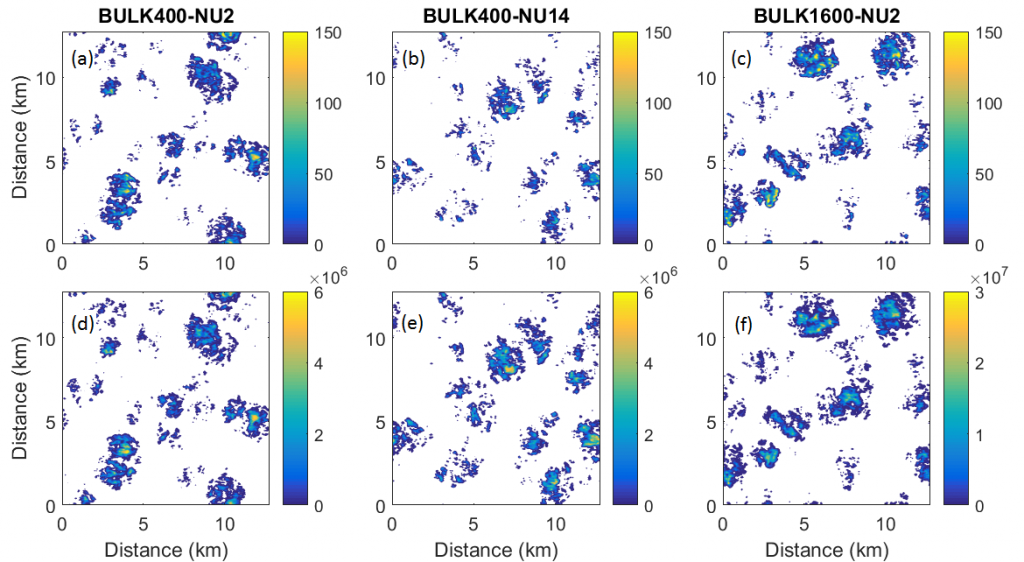
Uncertainty about the cloud droplet shape parameter can have big impacts on the properties of simulated clouds. Figure 2 from the paper (above) shows that the cloud fraction is impacted more by the choice of shape parameter than by the aerosol concentration in simulations of shallow cumulus clouds. The top row shows liquid water path, and the bottom row shows vertically integrated droplet concentration. Focus though on the percentage of the domain covered in colors to see the change in cloud fraction.
2016 and Earlier:
Igel, A. L., M. R. Igel, and S. C. van den Heever, 2015: Make it a double? Sobering results from single- and double-moment microphysics simulations. J. Atmos. Sci. 72, 910-925. [Link]
Paper Highlight
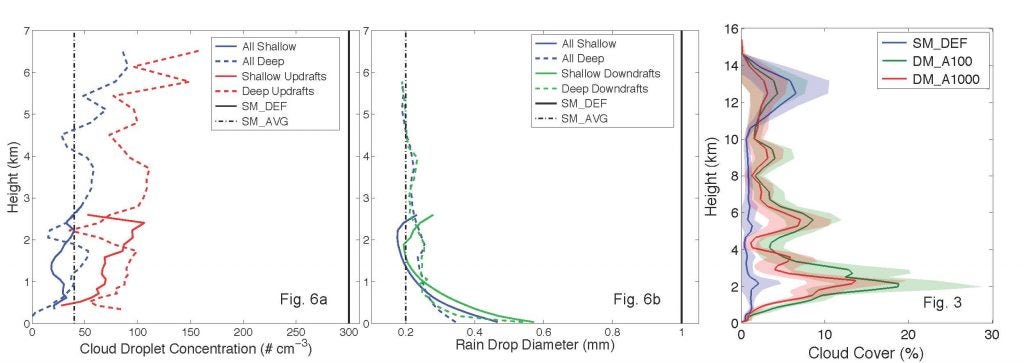
There are many papers in the published literature that demonstrate that double-moment microphysics schemes produce more accurate simulations than single-moment schemes. This paper summarizes those results and systematically argues for the use of double-moment schemes. These figures demonstrate that there is a wide variability in hydrometeor properties that cannot be captured by single-moment schemes. In our work we found was that the single-moment scheme under-predicted the low-level cloud fraction substantially in radiative-convective equilibrium simulations.
Igel, A. L., S. C. van den Heever, 2014: The role of latent heating in warm frontogenesis. Q. J. Roy. Meteor. Soc. 140, 139-150. [Link]
Paper Highlight

Panels from Figures 8, 11, and 12 showing the role of latent heating in frontogenesis, frontal stability, and the frontal slope. The values in the first two panels are combined mathematically to arrive at the values in the third panel. The results indicate that one impact of latent heating is to weaken the warm front in the sense that the slope is reduced and thus weaker vertical velocities may be expected.
Igel, A. L., S. C. van den Heever, C. M. Naud, S. M. Saleeby, and D. J. Posselt, 2013: Sensitivity of warm frontal processes to cloud-nucleating aerosol concentrations. J. Atmos. Sci. 70, 1768-1783. [Link]
Paper Highlight
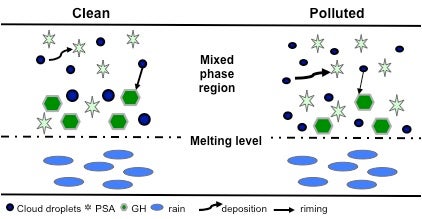
Fig. 13. Summary schematic showing the changes to the microphysical properties of the mixed-phase portion of the warm-frontal cloud and the total precipitation. Vapor deposition onto pristine ice, snow and aggregates (PSA) increases (as indicated by the change in arrow thickness) while riming of the mixed-phase species (GH) decreases. These two trends in the growth of ice mass cancel one another resulting in little change in the total ice mass and little change in rain production through melting. Differences in size and number of hydrometeors between the clean and polluted scenarios indicate qualitative changes.
Meskhidze, N., L. A. Remer, S. Platnick, R. N. Juarez, A. M. Lichtenberger, and A.R. Aiyyer (2009), Exploring the differences in cloud properties observed by the Terra and Aqua MODIS Sensors, Atmos. Chem. Phys., 9, 3461-3475. [Link]

















